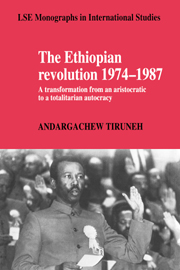 The Ethiopian Revolution 1974–1987
The Ethiopian Revolution 1974–1987 Book contents
- Frontmatter
- Contents
- List of maps and tables
- Acknowledgements
- List of abbreviations
- Map 1 The Horn of Africa
- Map 2 Administrative divisions
- 1 The background to the emergence of the structural crisis
- PART I THE COLLAPSE OF THE OLD-STATE (JANUARY–NOVEMBER 1974)
- PART II THE FORMATIVE YEARS OF THE POST-REVOLUTIONARY ORDER (DECEMBER 1974–FEBRUARY 1977)
- 4 The socio-economic reforms of 1975
- 5 The upsurge of political organizations
- 6 Scientific socialism and the structure of the government
- 7 From a junta to an autocratic dictatorship
- PART III CONSOLIDATION OF POWER (FEBRUARY 1977–SEPTEMBER 1987)
- Postscript
- Appendix: chronology of events
- Notes
- Bibliography
- Index
- LSE MONOGRAPHS IN INTERNATIONAL STUDIES
7 - From a junta to an autocratic dictatorship
Published online by Cambridge University Press: 18 December 2009
- Frontmatter
- Contents
- List of maps and tables
- Acknowledgements
- List of abbreviations
- Map 1 The Horn of Africa
- Map 2 Administrative divisions
- 1 The background to the emergence of the structural crisis
- PART I THE COLLAPSE OF THE OLD-STATE (JANUARY–NOVEMBER 1974)
- PART II THE FORMATIVE YEARS OF THE POST-REVOLUTIONARY ORDER (DECEMBER 1974–FEBRUARY 1977)
- 4 The socio-economic reforms of 1975
- 5 The upsurge of political organizations
- 6 Scientific socialism and the structure of the government
- 7 From a junta to an autocratic dictatorship
- PART III CONSOLIDATION OF POWER (FEBRUARY 1977–SEPTEMBER 1987)
- Postscript
- Appendix: chronology of events
- Notes
- Bibliography
- Index
- LSE MONOGRAPHS IN INTERNATIONAL STUDIES
Summary
The previous chapters have shown how the Derg emerged as a collective body of absolute government power in 1974; how that power fell into the hands of an officers' junta by the beginning of 1975; and how that junta adopted radical socio-economic and ideological policies in 1975 and 1976. The adoption of NDRPE (scientific socialism) was the last important collective act of the junta. The adoption of this ideology was perhaps important in giving the changes some sense of direction; at the same time, however, it appears to have brought to the forefront the question of power, which has a greater claim on the minds of those engaged in the business of politics than does ideology. The present chapter is concerned mainly with the power struggle within the officers' junta and with the process of Mengistu Haile-Mariam's emergence from that as the absolute head of state.
The chapter is divided into three sections. Section A deals with the configuration of coalitions among the political groups in the country and with how, as part of the leadership of one of these coalitions, Mengistu rallied support around himself, thus posing a challenge to the pre-existing collegiality among the officers' junta of the Derg. Section B deals with the response of the junta to Mengistu's challenge; and section C with Mengistu's victory over the junta.
MENGISTU'S CHALLENGE TO THE OFFICERS' JUNTA
As noted in the previous chapter, no less than seven pan-Ethiopianist organizations had sprung up on the political scene of Ethiopia by 1976.
- Type
- Chapter
- Information
- The Ethiopian Revolution 1974–1987A Transformation from an Aristocratic to a Totalitarian Autocracy, pp. 173 - 202Publisher: Cambridge University PressPrint publication year: 1993


